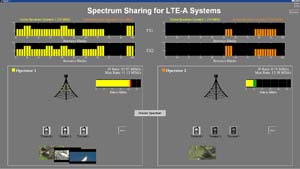Jointly utilizing LTE networks

Intelligent algorithms permit decentralized control of the distribution of radio frequencies in LTE networks. © Fraunhofer HHI<br>
Data-intensive Internet applications on smartphones, tablets and laptops are more popular than ever before. The result: Traffic on the mobile network is increasing at a blinding speed. Intelligent technologies are intended to increase the data rates on the new LTE network. The solution is to use the mobile networks jointly.
Smartphones and tablets are some of the big sellers of the past year. Mobile Internet usage has increased rapidly with the sales success: according to a study of the industry association VATM, in 2011 the average data volume per mobile Internet user increased by 82 percent in Germany. In contrast to its predecessor UMTS, with the new LTE mobile radio standard, the clearly higher data rates and the shorter signal transmission times, providers want to cover the expected traffic. That is why the expansion of the LTE network is being pursued aggressively. Providers are setting up ever more base stations to prevent data bottlenecks, because with each new sending and receiving station increases network capacity. Basically, a network can be densified as much as desired. Neighboring base stations often use the same frequencies, and networks can cope with the resulting interference between the cell towers. However, this also means setting up ever more mobile radio antennas, which drives up costs and takes a great deal of time.
Researchers at the Fraunhofer Institute for Telecommunications, Heinrich Hertz Institute HHI in Berlin have developed new solutions to meet the growing requirements. The idea: two or more providers use the network jointly, meaning they are sharing the frequencies and the infrastructure. “This way, for example, customers of network provider A in Bavaria could use the base stations of network provider B in Brandenburg and vice versa,“ says Dr. Volker Jungnickel of HHI. LTE Spectrum Sharing, as the experts call their technology, offers providers many advantages beyond cost savings. They can close coverage gaps and make LTE available more quickly in rural areas.
“In the city, by combining the functions, they can double the density of the base stations and thus the capacity of both networks. The data rate per surface area increases, and more users are provided with service at the same time without having to erect new antennas. The end user profits from shorter downloading and uploading times,“ the researcher explains. On top of that, short-term peak loads can be absorbed reciprocally: if one network is under particular stress, one network partner can increase its bandwidth by borrowing frequency shares from another network partner. Because frequencies can be divided up dependent not only of load but also of channel, if the reception is bad in one‘s own network, one can simply use the spectrum of the partner network.
LTE spectrum sharing is made possible by intelligent algorithms that control the allocation of the radio frequencies in a decentralized way. For this to happen, certain information, such as the traffic load, the quality of the channel, and which services are being used at the moment is exchanged between providers. “With our technology, networks can coordinate to provide access to additional radio resources in the network of the partner. With the aid of fixed rules, we can distribute signal processing across networks, so no central control is required,“ Jungnickel points out. The researchers will be on hand to demonstrate how this works, live and in real-time, at the Mobile World Congress in Barcelona from February 27 – March 1, 2012 in Hall 2, Booth E41.
Media Contact
All latest news from the category: Information Technology
Here you can find a summary of innovations in the fields of information and data processing and up-to-date developments on IT equipment and hardware.
This area covers topics such as IT services, IT architectures, IT management and telecommunications.
Newest articles

Properties of new materials for microchips
… can now be measured well. Reseachers of Delft University of Technology demonstrated measuring performance properties of ultrathin silicon membranes. Making ever smaller and more powerful chips requires new ultrathin…

Floating solar’s potential
… to support sustainable development by addressing climate, water, and energy goals holistically. A new study published this week in Nature Energy raises the potential for floating solar photovoltaics (FPV)…

Skyrmions move at record speeds
… a step towards the computing of the future. An international research team led by scientists from the CNRS1 has discovered that the magnetic nanobubbles2 known as skyrmions can be…





















